The 3rd Asia-Pacific CBR Congress
Plenary Session 2
Speaker: Emi Aizawa, Director, Social Security Team, Human Development Department, Japan International Cooperation Agency (JICA)
Title: JICA’s Approach to Facilitating the Development of Empowered Communities – From a Disability and Development Perspective–
CBID from a development perspective
Collaborative efforts among the governments, civil society and development agencies towards the achievement of the Millennium Development Goals (MDGs) has led to some remarkable outcomes such as halving extreme poverty rates and the proportion of the population without sustainable access to safe drinking water and basic sanitation. On the other hand, we still see large disparities among regions, countries and groups within countries, such as by gender and income. The MDGs do not refer to disability, and the data concerning MDGs is not disaggregated by disability. Considering that persons with disabilities make up about 15 per cent of the world population and that poverty and disability are deeply connected, it can be assumed that persons with disabilities tend to be excluded from the process towards the achievement of the MDGs and its benefits and that there remains a huge disparity due to disability.
On the other hand, the Post-2015 Development Agenda clearly mentions persons with disabilities in the targets on education, employment as well as accessible transport systems and public spaces. Disability is also mentioned under such issues as human rights and empowerment. Efforts towards building a society which respects diversity including disability, race, gender, age, and language as a natural condition are essential in achieving the Post-2015 Development Agenda. A community-based approach to inclusive development, which makes sure that diversity is respected and that there is no exclusion of specific groups, is key to achieving the goals.
JICA aims to achieve “inclusive and dynamic development”, which is the organization’s vision, through carrying out four missions, which include “achievement of human security” Human security places importance on the development of a community in which all members can live safely through a human-centered approach, protection of people from threats such as poverty and disasters, capacity development of individuals and collaboration with multiple stakeholders. These vision and mission have much commonality with community-based inclusive development (CBID). CBID is an effective approach towards JICA’s vision as well.
CBID from a disability perspective
In order for persons with disabilities to participate in CBID on an equal basis with others, understanding of disability must be shared among community members and physical and social accessibility must be in place. JICA’s experiences show that it is most effective that persons with disabilities take lead in these efforts through, for example, becoming facilitators of Disability Equality Training, peer counseling and accessibility check. Capacity development of persons with disabilities on these skills has promoted their empowerment and enabled them to contribute greatly to the development of an inclusive community in collaboration with other stakeholders. For proactive participation of persons with disabilities in addressing community issues, this approach has been one of the success factors in JICA-supported activities. Two examples are shown below.
Case 1: Resilience of a community strengthened through addressing barriers for persons with disabilities
The project which started with an aim to address the issues persons with disabilities were facing did not only create a better environment for them but also led to the increase of community resilience to natural disasters.
The Project for Creation of Non-handicapping Environment for Filipinos with Disabilities in the Rural Areas (2008~2012), implemented in collaboration with the National Council on Disability Affairs, aimed to remove physical and social barriers, such as inaccessible built environment and negative attitude, which were hindering persons with disabilities from social participation. In the two target cities in rural settings, namely, New Lucena of Iloilo Province and Opol of Misamis Oriental Province, persons with disabilities played the central role in improving accessibility in close collaboration with the municipal governments. For example, they compiled information on persons with disabilities and strengthened their self-help groups through home visits and peer counseling. They also received training and became DET facilitators and resource persons in accessibility check. At the city level, a project management team consisting of persons with disabilities, families, city government officials and community members was established and developed activity plans. Furthermore, coordination bodies were set up at the provincial level and the national level so that the outcomes of the activities in the target cities would be shared with other local governments.
Through this process, universal design was adopted in various buildings and structures. In addition, the city governments adopted ordinances on the right of persons with disabilities and accessibility. They also increased the budget allocated to the activities related to disability. The community members deepened their understanding of disability and more persons with disabilities started going out more and taking part in social activities, including employment.
Another remarkable impact of the project is that when the region was devastated by the typhoon Yolanda in 2013, the environment with improved accessibility contributed to the evacuation of not only persons with disabilities but also other community members. Moreover, utilizing the peer counseling skills they acquired through the project, persons with disabilities provided emotional support to one another in this time of hardship.
Case 2: Disability mainstreaming in community response to disaster
Another project in the Philippines started with an aim to address an urgent issue in the community, which was disaster risk reduction, and a disability perspective was mainstreamed to promote inclusion.
The Community Based Adaptation and Resilience Against Disasters Project (2012~2015) was implemented through partnership among Iloilo City, CITYNET, Yokohama City and JICA. The disaster risk reduction expertise of Yokohama City, where a hazard map was created by a neighborhood association and local authorities for the first time in Japan, was shared with the partners in the Philippines. In contrast to the Case 1 project which focused on the rural areas, the target areas of this project were five local districts in the provincial capital of Iloilo and the project aimed to strengthen the community disaster prevention capacities to reduce the loss of lives and damages to properties. The Iloilo River basin is prone to flood hazards caused by typhoons and torrential downpours. Alongside the river, low income households set up dwellings and are particularly vulnerable to disaster risks.
The project facilitated the participation of various stakeholders including local government officials, health workers, older persons and youth from the planning stage, however, persons with disabilities were not included at the beginning. A Japan Overseas Cooperation Volunteer who was dispatched to the Association of Disabled Persons ? Iloilo (ADP-I) initiated exchange between the cities of Iloilo and New Lucena, the latter of which had been identified as a model local government unit for accessible community by the National Council on Disability Affairs and JICA. ADP-I members conducted DET and accessibility check and contributed to awareness raising among community members and the improvement of physical accessibility. As a result, information on persons with disabilities and older persons particularly exposed to disaster risks was compiled, universal design was adopted in public buildings and toilets, and persons with disabilities began taking part in the development of hazard maps and evacuation drills.
Due to the increased preparedness, the target areas saw no casualties at the time of typhoon Yolanda. Persons with disabilities proactively contributed to the relief efforts, utilizing the information collected beforehand about the whereabouts of those who are in need of support and the network among community members strengthened through the project activities.
Building on the outcomes of the project, another project is now being implemented in Iloilo city to strengthen the risk control system of the city. In this project, inclusion of persons with disabilities, older persons, women and children is clearly mentioned in the project framework from the beginning, and it is expected that an effective model of inclusive disaster risk reduction will be developed.
Lessons learned and challenges ahead
These examples illustrate two effective approaches. One is the approach to start with addressing issues from a disability perspective in collaboration with other community members. The other approach aims to address common issues faced by community members and a disability perspective is mainstreamed in the process. In both approaches, it is crucial that persons with disabilities contribute to the improvement of the community as active participants, not as vulnerable group in need of protection.
JICA is determined to reflect these lessons in other projects. In a project launched in Colombia in March this year, two municipalities which had gone through much hardship during the internal conflicts were selected as target areas. A baseline survey will identify the difficulties persons with disabilities are facing, common issues among community members and existing social capital. Based on the result of the survey, a set of activities appropriate for each municipality will be implemented by community members including persons with disabilities. Furthermore, in another project to be started in Mongolia next year which aims to promote social inclusion of persons with disabilities in Ulaanbaatar, we would like to see persons with disabilities contributing to the development of an inclusive community.
In order for national and local governments and development agencies to recognize the effectiveness of CBID and promote its implementation by including it in the development plans and budget, it is critical that we visualize positive impacts brought about in the community in terms of both empowerment and inclusion. We at JICA are working on the implementation of an effective baseline survey and the development of indicators to measure those impacts and we are keen to cooperate with our partners on the development of such tools to promote CBID.
END
Slide 1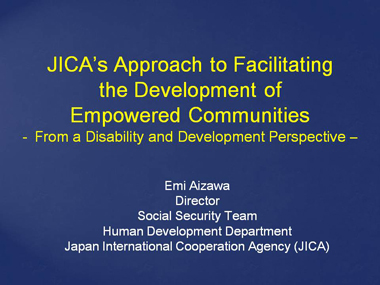 (Slide 1 text)
(Slide 1 text)
Slide 2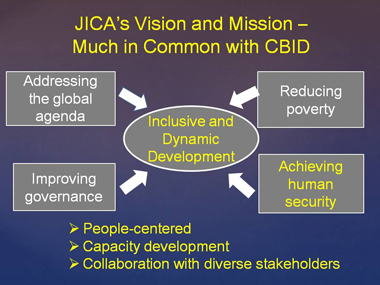 (Slide 2 text)
(Slide 2 text)
Slide 3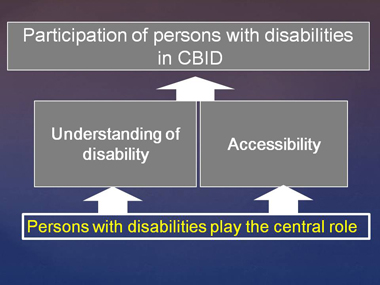 (Slide 3 text)
(Slide 3 text)
Slide 4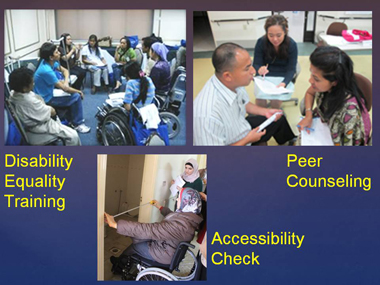 (Slide 4 text)
(Slide 4 text)
Slide 5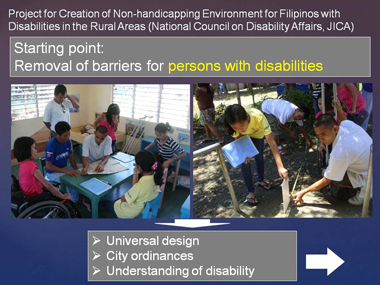 (Slide 5 text)
(Slide 5 text)
Slide 6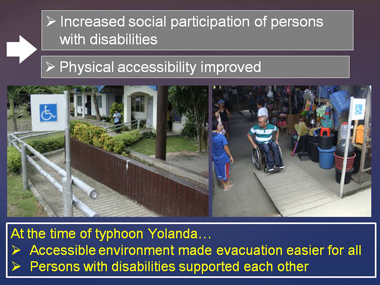 (Slide 6 text)
(Slide 6 text)
Slide 7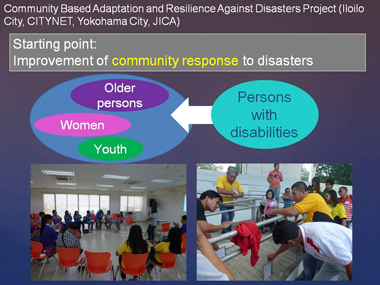 (Slide 7 text)
(Slide 7 text)
Slide 8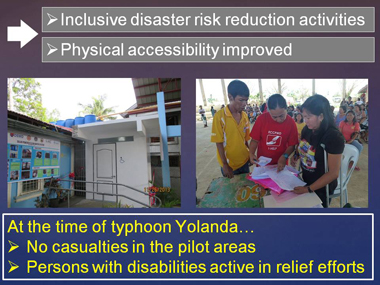 (Slide 8 text)
(Slide 8 text)
Slide 9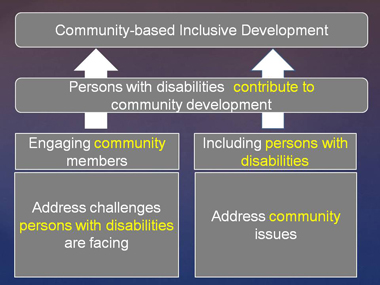 (Slide 9 text)
(Slide 9 text)
Slide 10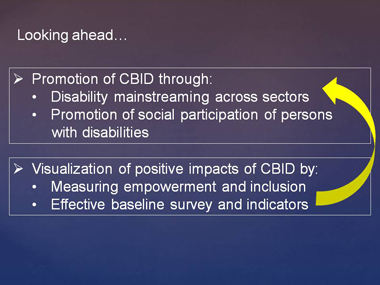 (Slide 10 text)
(Slide 10 text)
